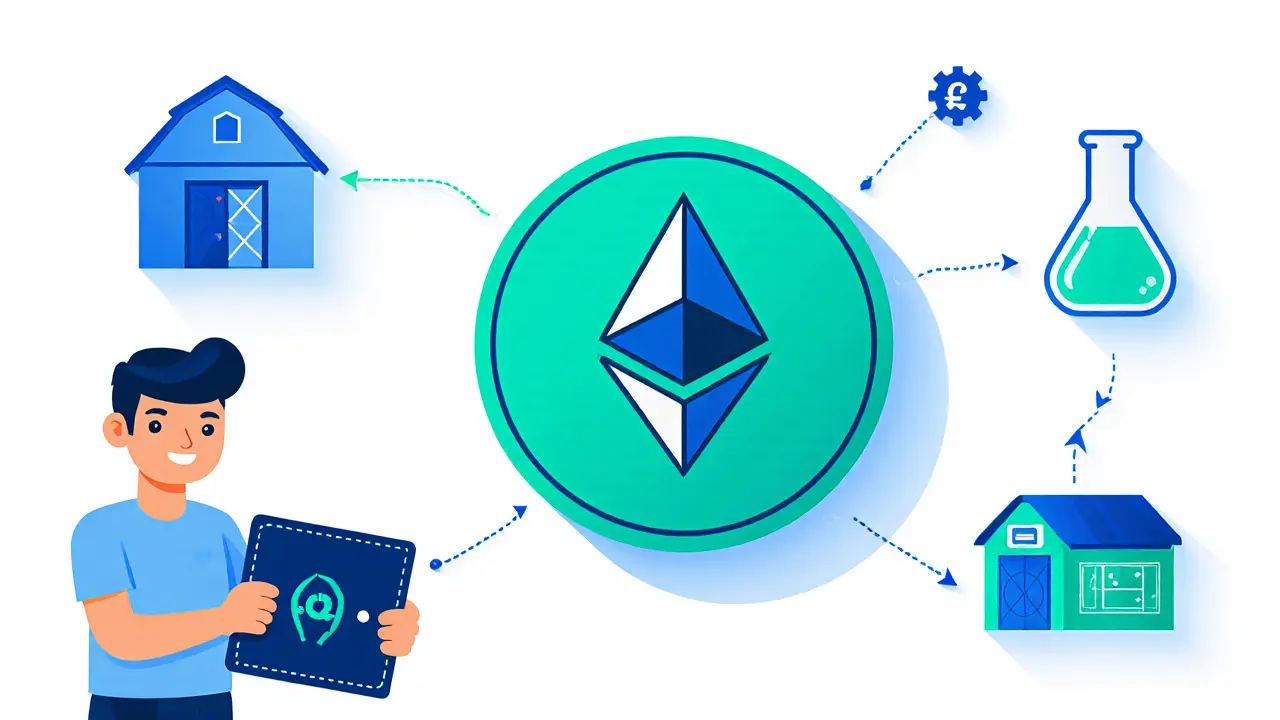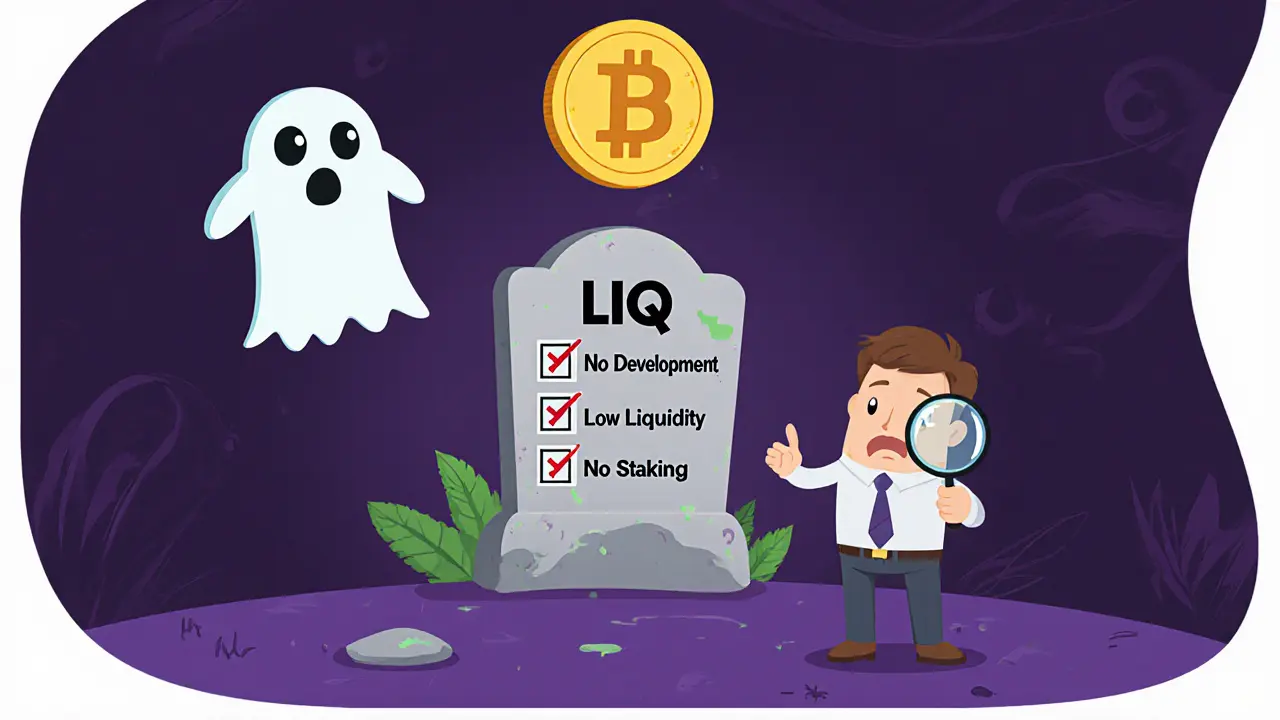Crypto Exchanges Accepting Iranian Users - 2025 Guide
A 2025 guide listing crypto exchanges that still accept Iranian users, covering domestic options, international platforms, fees, security, and recent regulations.
Read More

This tool helps you assess the viability of cryptocurrency tokens by analyzing key metrics that indicate whether a project is actively maintained and has sustainable liquidity. Based on the criteria shown below, it provides a risk score and recommendations.
Enter values for key metrics to assess a token's viability. Use the sliders to adjust values (1 = low risk, 10 = high risk).
Based on article data:
- Development Activity: 8 (No commits since 2022)
- Daily Trading Volume: 9 (Under $20/day)
- Community Engagement: 9 (Telegram down to 1.2k members)
- Exchange Listings: 9 (Only on DEXs like ApeSwap)
Liquidus (old) (LIQ) token was launched on the Ethereum blockchain as a utility token for a DeFi yield‑aggregation platform. The project marketed itself as a "one‑stop solution for earning decentralised interest," automatically routing users' assets to the highest‑yield farms across multiple protocols.
The core idea was simple: hold LIQ, connect a Web3 wallet, and let the platform find the best staking opportunities without manual research. In theory, that would save time and improve returns for average crypto holders.
Ethereum hosts the token with the contract address 0x5f69b8c95b1c5d5d5d5d5d5d5d5d5d5d5d5d5d5d (truncated for brevity). The total supply is capped at 93 million LIQ, with about 6.56 million circulating.
These numbers come from Coinbase’s market data (Oct 2023) and CoinMarketCap (Aug 2025). No token burn or mint mechanisms have been announced.
LIQ’s price chart reads like a classic DeFi boom‑and‑bust story. After a meteoric rise to an all‑time high of $4.80 on 10 Nov 2021, the token slid down to $0.007 USD by late August 2025-a 99.82 % drop.
Market caps vary by source: CoinMarketCap listed roughly $56 k USD, while Coinbase showed about $38 k USD. Trading volume is minuscule, often under $200 USD per day, and many major exchanges (including Binance) do not list the token at all.
Because liquidity is thin, even tiny trades suffer high slippage (often >15 %). The LIQ/WBNB pair on ApeSwap dominates the scant volume, accounting for about half of the daily $10‑$20 USD traded.

Liquidity pools exist mainly on Binance Smart Chain‑based DEXes though the token is an ERC‑20 asset. The most common interfaces are:
To trade, you need a Web3‑compatible wallet such as MetaMask, connect it to the DEX, and swap a small amount of BNB or ETH for LIQ. Expect transaction failures if you try to move more than the daily volume can absorb.
Several factors contributed to the token’s downfall:
All these issues mean the platform that supposedly handled staking is likely defunct, making any remaining LIQ holdings essentially unredeemable.
| Feature | Liquidus (LIQ) | Yearn.finance (YFI) | Beefy.finance (BIFI) |
|---|---|---|---|
| Launch Year | 2021 | 2020 | 2020 |
| Current Price (USD) | ~0.007 | ≈4,800 | ≈30 |
| 24‑h Volume (USD) | <100 | ≈120 M | ≈8 M |
| Active Development | No (since 2022) | Yes (weekly updates) | Yes (monthly audits) |
| Liquidity Sources | Small DEX pools only | Multi‑chain aggregators, major exchanges | Broad DEX+CEX support |
| Community Size (Telegram) | ≈1 200 | ≈75 000 | ≈32 000 |
The table makes it clear that LIQ no longer competes on any meaningful metric. For anyone looking for active yield farming, the other two tokens are far more viable.

If you stumble upon LIQ on a DEX, ask yourself these questions:
Ignoring these warnings can lead to a total loss of the few cents you might invest. The token’s classification as a “zombie token” by multiple threat‑intelligence firms underscores the danger.
When you encounter an obscure coin like LIQ, follow this quick checklist:
Applying this framework will save you from chasing dead projects.
Liquidus (LIQ) token should be considered a high‑risk, likely‑to‑disappear asset. Its original promise of automated DeFi yield has been eclipsed by more transparent, actively maintained platforms. With near‑zero liquidity, no development, and a price that has collapsed 99 % from its peak, the token offers little upside and substantial downside.
For seasoned DeFi users, the token may still appear on DEX charts as a curiosity, but the prudent move is to avoid new exposure and, if you already hold LIQ, consider exiting while you still can.
LIQ was designed as a utility token for a DeFi platform that automatically routed users' assets to the highest‑yield farms. In practice, the platform never delivered a stable staking service.
No. The staking interface has been offline since 2022, and there have been no updates or replacements from the developers.
LIQ trades only on a few decentralized exchanges such as ApeSwap, Biswap, and PancakeSwap. It is not listed on major centralized exchanges like Binance or Coinbase.
Given its negligible liquidity, lack of development, and price that has collapsed 99 % from its peak, LIQ is not a recommended investment. Safer alternatives exist for yield farming.
Use the checklist in the article: verify the website, inspect the contract on Etherscan, review activity on aggregators, read community sentiment, and confirm exchange listings. Absence of recent activity across these points signals abandonment.
This is the exact kind of post that saves people from losing money. Zero development since 2022? No liquidity? 99% drop? If you're holding this you're already in the graveyard. Just walk away.
so like... the token is basically a digital ghost? like it still exists on the blockchain but nobody cares anymore? i mean thats wild. i thought zombies were just for halloween. turns out crypto has its own undead economy. 🤡
i saw this token pop up on my wallet last week and thought 'huh maybe its a hidden gem'... then i checked the volume and realized i was about to throw $5 into a black hole. glad i didnt.
why do people still even look at tokens like this? i mean if the website 404s and the devs vanished 2 years ago you're not investing you're just gambling on a ghost story. and even then the ghost is broke.
there's something almost poetic about a token that was supposed to automate yield but ended up automating its own obsolescence. the market didn't kill it. neglect did. and that's the quietest kind of death.
just sell it already
⚠️ WARNING: LIQ is a DEAD PROJECT. ⚠️ If you have any LIQ in your wallet, DO NOT ADD MORE. Check Etherscan. No new transactions. No updates. No community. Just a silent contract. Exit while you can. You’re not missing out-you’re avoiding a trap. 💔
you know what's funny? people treat this like it's a financial decision. but it's not. it's a ritual. like leaving flowers at a closed church. you're not praying for returns-you're mourning the illusion that crypto ever made sense.
if you're still holding LIQ you're either delusional or you think the devs will magically come back and fix everything like it's a Netflix reboot. newsflash: no one cares. the code is dead. the team is gone. your hope isn't an asset
this is why you always check the website first 😅 if it's down, the project is dead. no exceptions. no excuses. just move on to something real
This is a textbook case of why due diligence is non-negotiable in DeFi. A token without active development, transparent audits, or community engagement is not an investment-it is a liability. For those who hold LIQ: I urge you to liquidate, document your loss, and redirect your energy toward protocols with verifiable, ongoing contributions. Your future self will thank you.

A 2025 guide listing crypto exchanges that still accept Iranian users, covering domestic options, international platforms, fees, security, and recent regulations.
Read More
A thorough review of Uniswap v2 on Soneium, covering fees, wallet setup, liquidity, risks, and future outlook for this entertainment‑focused Layer 2 DEX.
Read More
An in‑depth look at Russia's new pilot law that permits cross‑border Bitcoin settlements, who can use it, compliance steps, and its impact on trade and investors.
Read More
Comments (11)